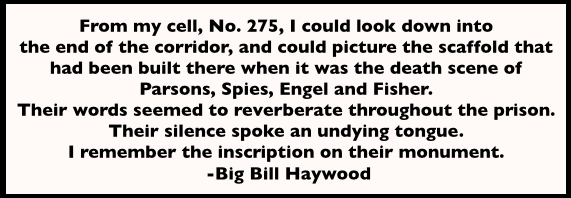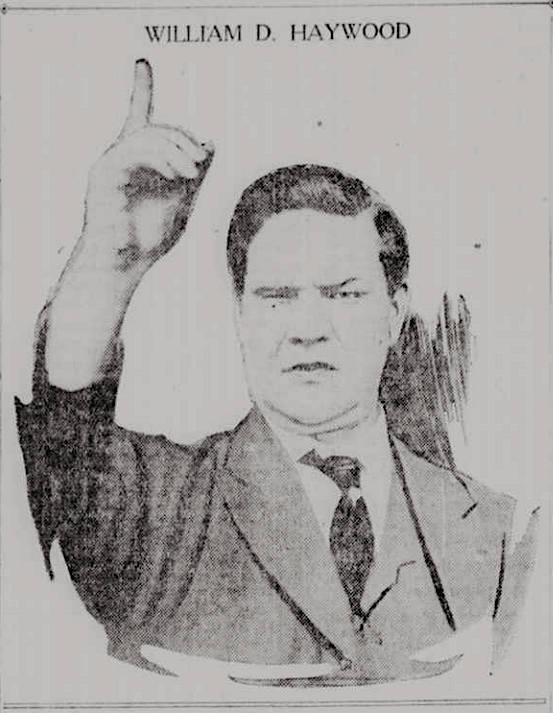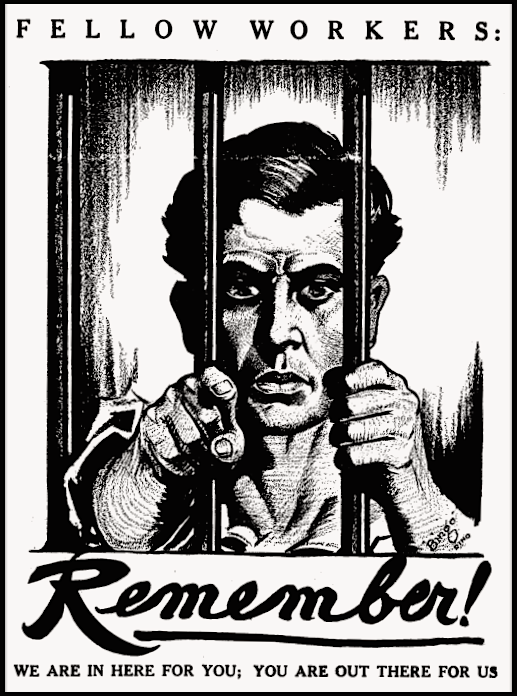
Hellraisers Journal, Thursday February 21, 1918
Big Bill Haywood Now Out on Bail from Cook County Jail
From North Carolina’s Cleveland Star of February 19, 1918:
William D. Haywood, international secretary and treasurer of the I. W. W., who with 165 other members of that organization, was indicted by a Federal grand jury in Chicago on a charge of conspiracy and sedition, has been released in bond of $15,000.
———-
[Photograph added.]
From The Chicago Daily Tribune of February 13, 1918:
HAYWOOD FREED ON $15,000 BOND
OVER U. S. PLEA
—–
Government Fears He Will Become Active
as an I. W. W. Agent.
—–
William D. Haywood, international secretary of the I. W. W., and recognized as its guiding spirit, was released yesterday under $15,000 bond. He had been in jail since Sept. 28. Judge Landis permitted the reduction of the bond from $25,000.
The bond was signed by George W. Kohler, 9236 Commercial avenue; Jacob Brunning and his wife, Catherine, 4243 Lowell avenue, and William Bross Lloyd, capitalist and Socialist.
“I’ll take a chance,” was Judge Landis’ comment in granting Haywood’s release, after District Attorney Clyne and Frank K. Nebeker, special assistant attorney general, had opposed the action, declaring that Haywood, once out of jail, would at once renew his anti-government activities.
Court Bound by Facts.
Judge Landis outlined his position in granting Haywood’s freedom by remarking:
“I cannot take into consideration the fact that Haywood, if released, would tour the country in an offensive campaign against the government as represented by the federal attorneys. However, I have considered that as a possibility in this case. I am not permitted as a judge to take cognizance of that fact in fixing a bond. Should this be the circumstance, it may be considered in the fixing of other bonds when application is made by other members of this organization. ”
Haywood, pale from long confinement, after signing his name to the bond in presence of bailiffs and the clerk of the court, was given his freedom in the federal building. A little group of admirers and I. W. W. members waited for him in the lobby downstairs.
Tells of I. W. W. “Tension.”
George F. Vanderveer, counsel for the I. W. W., in pleading for Haywood’s release, hinted that “something” might happen if the plea was denied, saying:
Your honor, the freedom of William D. Haywood, regarded as a hero by his fellow members, will relieve a certain tension. It has been felt by various of the I. W. W. members and sympathizers throughout the country that justice has not been done. This, your honor, is not intended as a threat.
The I. W. W. could stop industrial progress in this country. Instead they have shown a desire to aid in the carrying on of the industries of the country since the beginning of the war.
Seeks Martyrdom, Charge.
Attorney Nebeker reviewed the contents of the indictment against Haywood which charge him with obstructing the government’s conduct of the war against Germany. Then he added:
“This man does not want his freedom. He wants to hold himself out as a martyr.”
Haywood, after visiting the I. W. W. headquarters at 1001 West Madison street, apparently vanished. At the headquarters it was said he would see no one for the next two days.
———-
[Photograph added.]
SOURCES
The Cleveland Star
(Shelby, North Carolina)
-Feb 19, 1918
https://www.newspapers.com/image/76027031
The Chicago Daily Tribune
(Chicago, Illinois)
-Feb 13, 1918
https://www.newspapers.com/image/354984496/
IMAGES
BBH, NYTb p22, Dec 30, 1917
https://chroniclingamerica.loc.gov/lccn/sn83030214/1917-12-30/ed-1/seq-22
WWIR, In Here For You, Ralph Chaplin, Sol Aug 4, Sept 1, 1917
p323 https://libcom.org/files/rebel-voices-2_0.pdf
See also:
Tag: Big Bill Haywood
https://weneverforget.org/tag/big-bill-haywood/
Tag: World War I Repression
https://weneverforget.org/tag/world-war-i-repression/
William Bross Lloyd
https://en.wikipedia.org/wiki/William_Bross_Lloyd
Haywood describes his time in Cook County Jail
-from Sept 28, 1917 to February 12, 1918:
Bill Haywood’s Book
The Autobiography of William D. Haywood
-by Big Bill Haywood
International Publishers, 1929
https://catalog.hathitrust.org/Record/000859708
Note: Haywood’s account of his time in the Cook County Jail begins at bottom of page 303 and continues to page 308 where he states: “Early in the spring of 1918, I was released on bail.”
https://babel.hathitrust.org/cgi/pt?id=mdp.39015050276461;view=2up;seq=306
From [the Federal Building] we were taken into the subway of the building, loaded into patrol wagons and driven to Cook County jail…
This was the same jail in which the Haymarket martyrs were imprisoned for eighteen months and where they were hanged. I did not learn the numbers of the cells that they occupied, but it is certain that some of us lived in those cells while we were in the place…
The jail is in the heart of Chicago on the corner of Austin Avenue and Dearborn Street. It is a forbidding and filthy old structure built of gray granite. The cell houses are in a quadrangle. Long barred windows, like gashes in a cliff, face the street. The bottom of the windows are high up from the street. The glass had long lost its transparency because of years of accumulation of dust and cobwebs. The cells were built in tiers, back to back, barred doors face the outside walls. The cells were painted black and were dirty with dust and tobacco spit. A rusty iron basin and toilet stood in the corner behind the bunks. The heat and water pipes were slimy and rusted red. Three narrow bunks, one over the other, occupied more than one-half the space. In each bunk were old papers and a dirty mattress of straw, old and lumpy. The scanty bedding was filthy, reeking with vermin and disease.
It was three paces from the rear wall to the door. To take these three steps one had to put all the furniture, which consisted of one stool, on the bed. I had the lower bunk. In looking up at the old newspapers on the bottom of the bunk above me, I saw a picture of myself. I got the paper out. It was an old issue of one of the Chicago dailies. There were no lights in the cells except the little that trickled through the bars from the screened electric globe outside the door. All the prisoners were kept locked in these cells for twenty hours a day. To read was difficult on account of the dim light. Two hours in the forenoon and two hours in the afternoon, the prisoners were let out for exercise, and walked in a slow measured pace around and around the corridor, called the bull-pen. It was always gloomy, and the floor upon which the sun had never shone was wet and slippery with spit and slime. The laws of the country made no distinction between criminal and political prisoners.
In the morning we were arouse by the raucous voice of the runner, calling “Cups out, cups out.” We held our cups through the bars, one trusty filled them with a noxious fluid, a substitute for coffee, another gave us some chunks of bread. For dinner and supper the meals were more substantial, but often the food was unfit to eat. One day they brought in corned beef and cabbage. The beef was rotten and filled the prison with a vile stench. All the men shoved their plates off the galleries onto the floor below, the air was filled with cabbage and strips of beef.
In this terrible prison over one hundred members of the I. W. W. were held over a year until their trial was finished.
[Drawing by Ralph Chaplin added.]


